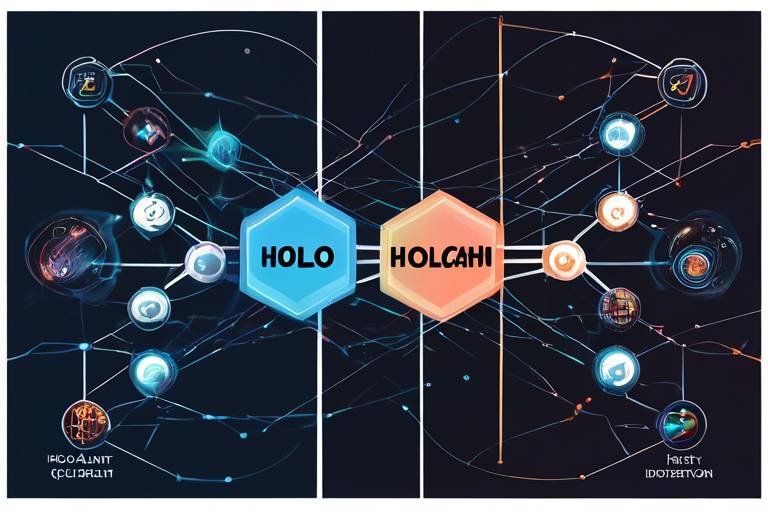Stafi - Staking Assets on the Blockchain
In the ever-evolving world of cryptocurrency, Stafi emerges as a beacon of innovation, redefining how we think about staking assets. Imagine a platform where you can earn rewards on your digital assets without sacrificing liquidity. Stafi does just that! By leveraging the power of decentralized finance (DeFi), it allows users to stake their crypto while still having access to their funds. This is a game-changer, especially for those who want to make their assets work for them without locking them away for extended periods.
So, what makes Stafi stand out in the crowded DeFi space? For starters, it combines the benefits of staking with the flexibility of liquidity. Users can stake their assets and receive rToken (reward tokens) in return, which can be traded or used in other DeFi applications. This dual functionality not only enhances user experience but also opens up numerous opportunities for yield farming and maximizing returns.
As we dive deeper into the Stafi platform, we'll explore its unique features, the mechanics of staking, and the various benefits it offers. From understanding the risks involved to choosing the right assets to stake, this article will provide a comprehensive overview of how Stafi is revolutionizing the way we interact with our crypto assets. Whether you're a seasoned investor or a newcomer to the crypto world, Stafi holds incredible potential for anyone looking to enhance their staking strategies.
In a nutshell, Stafi is not just another staking platform; it’s a fusion of accessibility, liquidity, and profitability that paves the way for the future of decentralized finance. So, buckle up as we embark on this journey to uncover the intricacies of staking on Stafi and how it can benefit you in the broader cryptocurrency ecosystem!

What is Stafi?
Stafi is a revolutionary decentralized finance (DeFi) platform that has emerged as a game-changer in the cryptocurrency landscape. Imagine being able to stake your crypto assets while still having access to liquidity—this is precisely what Stafi offers. Unlike traditional staking methods where your assets are locked away, Stafi allows you to earn rewards without sacrificing the flexibility of your investments. This unique approach not only enhances user experience but also opens up a world of opportunities for crypto enthusiasts.
The core functionality of Stafi revolves around a system that enables users to stake various cryptocurrencies while receiving rToken (reward tokens) in return. These tokens represent your staked assets and can be traded or utilized in other DeFi applications. This innovative mechanism ensures that users can maintain their liquidity while still benefiting from the rewards associated with staking. In essence, Stafi bridges the gap between staking and liquidity, making it an attractive option for both seasoned investors and newcomers to the crypto space.
Stafi's platform is built on a foundation of security and transparency, utilizing smart contracts to facilitate staking and reward distribution. This means that every transaction is recorded on the blockchain, providing users with a clear and immutable record of their staking activities. Furthermore, Stafi employs a robust governance model that allows the community to participate in decision-making processes, ensuring that the platform evolves in a way that reflects the needs and desires of its users.
As we delve deeper into the functionalities of Stafi, it becomes evident that this platform is not just about staking; it's about creating a comprehensive ecosystem that empowers users to take control of their financial futures. Whether you're looking to earn passive income, support network security, or explore the broader DeFi landscape, Stafi stands out as a versatile and forward-thinking solution.
In summary, Stafi represents a significant advancement in the world of crypto staking. By combining liquidity with the benefits of staking, it provides users with a unique opportunity to maximize their returns while minimizing risks. As the DeFi sector continues to grow, platforms like Stafi will play a crucial role in shaping the future of finance.

How Staking Works
Staking is a fascinating concept in the world of decentralized finance (DeFi), and understanding how it works is essential for anyone looking to maximize their crypto investments. At its core, staking involves locking up a certain amount of cryptocurrency in a wallet to support the operations of a blockchain network. This process not only helps maintain the network's security but also allows users to earn rewards in return for their commitment. Think of it as putting your money in a high-interest savings account, where your funds are working for you, generating passive income while you sleep.
On the Stafi platform, staking is designed to be user-friendly and efficient. When you stake your assets, you're essentially participating in the network's consensus mechanism, which validates transactions and secures the blockchain. In return for your contribution, you receive staking rewards, typically paid out in the same cryptocurrency you staked. This creates a win-win situation: you get to earn rewards while helping to secure the network. But how exactly does this process unfold? Let's break it down:
- Step 1: Choose Your Asset - First, you need to select the cryptocurrency you wish to stake. Stafi supports a variety of assets, allowing you to diversify your staking portfolio.
- Step 2: Lock Your Assets - Once you've chosen your asset, the next step is to lock it into the Stafi platform. This process is straightforward and can usually be completed with just a few clicks.
- Step 3: Earn Rewards - After locking your assets, you'll start earning rewards based on the amount you've staked and the duration of your staking period. It's like watching your money grow without lifting a finger!
However, it's crucial to understand that while staking can be profitable, it also comes with its own set of risks. Market volatility can impact the value of your staked assets, and there are potential vulnerabilities associated with smart contracts. Therefore, it's essential to conduct thorough research and consider factors like the project's track record and community support before diving in.
Moreover, Stafi enhances the staking experience by providing liquidity solutions. Traditionally, when you stake your assets, they become illiquid, meaning you can't access them until the staking period ends. Stafi addresses this concern by offering a unique mechanism that allows users to receive a liquidity token in exchange for their staked assets. This liquidity token can then be used in various DeFi applications, enabling users to participate in yield farming or trading while still earning staking rewards. It's like having your cake and eating it too!
In summary, staking on the Stafi platform is a straightforward process that offers numerous benefits. By locking your assets, you contribute to network security and earn rewards, all while having the flexibility to utilize your liquidity token in the broader DeFi ecosystem. Just remember to weigh the risks against the potential rewards, and you'll be well on your way to making informed staking decisions.
1. What is staking?
Staking is the process of locking up cryptocurrency to support the operations of a blockchain network, earning rewards in return for your contribution.
2. How do I start staking on Stafi?
To start staking on Stafi, choose the asset you want to stake, lock it into the platform, and begin earning rewards.
3. What are the risks of staking?
The risks include market volatility affecting the value of your staked assets and potential vulnerabilities in smart contracts.
4. Can I access my staked assets?
Stafi offers liquidity tokens in exchange for staked assets, allowing you to use them in other DeFi applications while still earning rewards.

Benefits of Staking
Staking has emerged as a revolutionary way for crypto enthusiasts to not only hold their assets but also earn rewards while doing so. Imagine sitting on a treasure chest that doesn’t just sit there but grows over time! That’s the essence of staking. By locking up your cryptocurrencies on the Stafi platform, you're not just securing your investment; you're actively participating in the network's health and security. This dual benefit is what makes staking so appealing to both novice and seasoned investors.
One of the most significant advantages of staking is the ability to earn passive income. When you stake your assets, you receive rewards in the form of additional tokens, which accumulate over time. This process is akin to earning interest on a savings account, but with potentially much higher returns. For instance, staking can yield annual percentage rates (APRs) that far exceed traditional banking rates. The more you stake, the more you earn, creating a compounding effect that can significantly boost your portfolio.
Moreover, staking contributes to the overall security and stability of the blockchain network. When users stake their assets, they help validate transactions and maintain the integrity of the blockchain. This decentralized approach not only enhances the network's performance but also promotes a sense of community among participants. Think of it as being part of a cooperative, where everyone’s contribution strengthens the whole. This aspect of staking fosters a collaborative environment, making it more than just a financial transaction.
Another benefit of staking on Stafi is liquidity. Unlike traditional staking methods where assets are locked away for extended periods, Stafi allows users to retain liquidity. This means you can stake your assets and still have the flexibility to access them when needed. It’s like having your cake and eating it too! This feature is particularly attractive for users who might want to capitalize on market opportunities without being tied down by their investments.
In addition to these benefits, staking can also serve as a hedge against market volatility. While the cryptocurrency market is notorious for its ups and downs, staking provides a more stable return on investment. By earning rewards through staking, users can offset potential losses from price fluctuations. It’s a bit like having an insurance policy for your crypto portfolio, providing a safety net during turbulent market conditions.
In summary, the benefits of staking on platforms like Stafi are multifaceted. From earning passive income and enhancing network security to enjoying liquidity and mitigating risks, staking offers a compelling case for crypto enthusiasts. As this innovative financial strategy continues to evolve, it’s essential for users to stay informed and take advantage of the opportunities it presents.
- What is staking? Staking is the process of locking up cryptocurrencies to support the operations of a blockchain network, earning rewards in return.
- How do I start staking on Stafi? To start staking on Stafi, first create an account, select the cryptocurrency you wish to stake, and follow the platform's instructions to lock your assets.
- Are there risks associated with staking? Yes, while staking can be profitable, it comes with risks such as market volatility and potential smart contract vulnerabilities.
- What rewards can I expect from staking? Rewards vary based on the asset staked and the staking mechanism but can often yield higher returns than traditional savings accounts.

Risks Involved in Staking
Staking can indeed be a fantastic way to earn passive income, but like any investment, it comes with its own set of risks that every potential staker should be aware of. First and foremost, one of the most significant risks is market volatility. The cryptocurrency market is notorious for its price swings, and the value of your staked assets can drop dramatically in a short period. Imagine putting your hard-earned money into a project, only to see the value plummet overnight due to market fluctuations. It’s a reality that many investors face.
Another risk to consider is smart contract vulnerabilities. Stafi, like other DeFi platforms, relies on smart contracts to facilitate staking. While these contracts are designed to be secure, they can still be susceptible to bugs and exploits. If a vulnerability is discovered, it could lead to loss of funds, making it essential for users to conduct thorough research and ensure they are using reputable platforms with a solid track record.
Moreover, there is the risk of liquidity issues. While Stafi offers liquidity solutions, not all staking platforms do. If you stake your assets, they are often locked up for a specific period, which means you can’t access or sell them during that time. If you need to liquidate your position due to unforeseen circumstances, you might find yourself in a bind. This lack of liquidity can be particularly concerning in a fast-moving market.
Additionally, network risks can also pose a threat. If the blockchain network you are staking on experiences technical issues or undergoes significant changes (like upgrades or forks), it could affect your staked assets. For instance, if the network goes down or if there are governance disputes, your staked rewards could be delayed or even lost entirely.
Lastly, it’s important to consider the regulatory risks. As governments around the world continue to develop regulations surrounding cryptocurrencies, there is always the potential for new laws that could impact your ability to stake or the profitability of your investments. Staying informed about the regulatory landscape is crucial for any investor.
In summary, while staking can be a lucrative venture, it’s essential to conduct due diligence and understand the risks involved. Being aware of market volatility, smart contract vulnerabilities, liquidity issues, network risks, and regulatory changes can help you make informed decisions and navigate the staking landscape more effectively.
- What is staking? Staking is the process of locking up cryptocurrency assets to support the operations of a blockchain network, earning rewards in return.
- Is staking safe? While staking can be safe, it carries risks such as market volatility and smart contract vulnerabilities. Always research before staking.
- Can I lose my staked assets? Yes, due to market fluctuations and smart contract issues, there is a possibility of losing your staked assets.
- How do I choose the right assets to stake? Evaluate the asset's market performance, community support, and the staking platform's reputation to make informed choices.
- What are the rewards for staking? Rewards vary depending on the asset and platform, but they typically include a percentage of transaction fees or newly minted coins.

Choosing the Right Assets to Stake
When it comes to staking on the Stafi platform, choosing the right assets is as crucial as picking the perfect ingredients for a gourmet meal. Just like how a chef selects only the freshest produce to create a culinary masterpiece, you need to evaluate various cryptocurrencies to maximize your staking returns. But how do you know which assets are worth your time and investment? Let's dive into some key factors that will help you make informed decisions.
First and foremost, consider the market capitalization of the assets you’re eyeing. Generally, larger market cap assets tend to be more stable and less volatile than smaller ones. This stability can provide a more predictable return on your staked assets. However, don't overlook smaller, emerging cryptocurrencies that have the potential for high rewards. They can be like hidden gems waiting to be discovered!
Next, take a close look at the staking rewards offered by different assets. Each cryptocurrency has its own reward structure, which can vary significantly. Some assets might offer high annual percentage yields (APY), but they could come with increased risks. It’s essential to strike a balance between potential rewards and the inherent risks associated with staking. A good rule of thumb is to aim for assets that offer a reasonable APY while maintaining a solid foundation of security and trust.
Another aspect to consider is the liquidity of the assets. Liquidity refers to how easily an asset can be converted into cash or another cryptocurrency without significantly affecting its price. High liquidity is advantageous because it allows you to access your funds quickly if you need to withdraw them. On the flip side, assets with low liquidity can be more challenging to sell, which might lock up your funds longer than you intend.
Don't forget to assess the project fundamentals behind the cryptocurrency. Investigate the team, technology, and use cases of the asset. Is the project actively developing? Does it have a robust community backing it? These factors can give you insights into the long-term viability of the asset. A strong project with a dedicated community is more likely to withstand market fluctuations and provide consistent staking rewards.
Lastly, it’s wise to diversify your staking portfolio. Just like you wouldn’t put all your eggs in one basket, spreading your investments across multiple assets can mitigate risks. By staking a variety of cryptocurrencies, you can balance out the potential downsides of any single asset while still capitalizing on the overall growth of the market.
In summary, choosing the right assets to stake on Stafi involves a mix of understanding market dynamics, evaluating staking rewards, considering liquidity, and analyzing project fundamentals. By taking the time to research and assess these factors, you can create a well-rounded staking strategy that maximizes your potential returns while minimizing risks. So, are you ready to dive into the world of staking? Your future self might just thank you for it!
- What is staking? Staking involves locking up your cryptocurrency to support the operations of a blockchain network in exchange for rewards.
- How do I choose the right assets to stake? Consider factors like market capitalization, staking rewards, liquidity, project fundamentals, and diversification.
- Is staking risky? Yes, while staking can provide rewards, it also carries risks such as market volatility and potential smart contract vulnerabilities.
- Can I unstake my assets anytime? This depends on the specific staking protocol. Some allow instant unstaking, while others may have lock-up periods.

Stafi's Unique Features
When it comes to standing out in the crowded world of decentralized finance, Stafi has carved a niche for itself with a suite of unique features that make it a compelling choice for both novice and seasoned crypto enthusiasts. One of the standout aspects of Stafi is its ability to provide liquidity while staking. Traditionally, staking requires locking up your assets for a fixed period, which can be a deterrent for many investors who fear losing access to their funds. However, Stafi has ingeniously tackled this issue by allowing users to mint rToken (reward tokens) that represent their staked assets. This means you can stake your crypto and still have liquidity to engage in other investments or trading activities. Imagine being able to enjoy the benefits of earning passive income while still having the flexibility to use your assets—it's like having your cake and eating it too!
Another remarkable feature of Stafi is its user-friendly interface. Even if you're not a tech wizard, navigating the platform is a breeze. The design is intuitive, ensuring that you can easily find the information you need, whether you're staking, checking rewards, or exploring other features. This accessibility is crucial, especially for newcomers who might feel overwhelmed by the complexities of DeFi. Stafi’s commitment to user experience is evident in every aspect of the platform, making it a welcoming space for everyone.
Moreover, Stafi is built on the premise of decentralized governance. Users are not just passive participants; they have a say in the platform's future. Through the governance token, R-Token holders can vote on critical decisions, including protocol upgrades and changes in staking rewards. This democratic approach fosters a sense of community and belonging, as users feel their voices matter in shaping the platform. It's a refreshing departure from traditional finance, where decisions are often made behind closed doors.
Additionally, Stafi’s cross-chain compatibility is a game-changer. In a world where various blockchains operate in silos, Stafi allows users to stake assets across different chains, enhancing interoperability and maximizing yield opportunities. This feature not only broadens the scope of assets you can stake but also helps in diversifying your portfolio, which is a crucial strategy in risk management. Think of it as having a multi-currency account that lets you take advantage of the best rates across different markets.
Lastly, Stafi emphasizes security and transparency. The platform employs robust smart contract audits and has a clear roadmap for future developments, ensuring that users can trust the integrity of their investments. With DeFi being a relatively new space, concerns about security are valid, and Stafi addresses these proactively. By being transparent about its operations and the measures taken to safeguard user assets, Stafi builds confidence among its community members.
In summary, Stafi's unique features—from liquidity solutions and user-friendly design to decentralized governance and cross-chain compatibility—set it apart in the DeFi landscape. As the platform continues to evolve, it holds great promise for users looking to maximize their staking experience while enjoying the perks of decentralization.
- What is Stafi? Stafi is a decentralized finance platform that allows users to stake their crypto assets while maintaining liquidity.
- How does staking work on Stafi? Users can stake their assets to earn rewards while receiving rTokens, which provide liquidity.
- What are the benefits of staking with Stafi? Benefits include earning passive income, supporting network security, and having access to liquidity.
- Are there risks involved in staking? Yes, risks include market volatility and potential vulnerabilities in smart contracts.
- How can I choose the right assets to stake? Evaluate the asset's market performance, staking rewards, and the overall project credibility.
- What makes Stafi different from other staking platforms? Stafi offers liquidity solutions, a user-friendly interface, and decentralized governance.

Integrating Stafi with Other DeFi Platforms
In today's rapidly evolving decentralized finance (DeFi) landscape, interoperability is a key factor that can significantly enhance the utility of platforms like Stafi. By integrating Stafi with other DeFi platforms, users can unlock a plethora of opportunities that not only maximize their staking rewards but also diversify their investment strategies. Imagine having a toolkit where each tool complements the other, creating a seamless experience that allows you to build your financial future with ease. That's precisely what Stafi aims to achieve through its integrations.
One of the standout features of Stafi is its ability to work in harmony with various DeFi applications, allowing users to leverage their staked assets across multiple platforms. For instance, when you stake your assets on Stafi, you don’t just earn rewards; you can also utilize those staked assets as collateral in other lending platforms or yield farming opportunities. This dual functionality can significantly amplify your returns.
Moreover, the integration with decentralized exchanges (DEXs) allows users to trade their staked assets without needing to unstake them first. This means you can maintain liquidity while still earning staking rewards, which is a game-changer for many investors. The ability to participate in liquidity pools while your assets are staked can lead to an exponential increase in your overall yield.
Here are some notable integrations that can enhance your experience on Stafi:
- Yield Farming Platforms: Users can stake their assets on Stafi and then use the staked tokens to farm yields on other platforms, creating a synergy that boosts overall returns.
- Lending Protocols: Stafi's assets can often be used as collateral to borrow other cryptocurrencies, allowing for leveraged trading strategies while still earning staking rewards.
- Liquidity Pools: By integrating with DEXs, users can provide liquidity using their staked assets, earning transaction fees while they hold onto their investments.
As the DeFi ecosystem continues to grow, Stafi is committed to expanding its integrations with other platforms. This not only enhances user experience but also fosters a more interconnected financial environment. The future of staking on Stafi is not just about earning rewards; it’s about becoming a part of a larger financial ecosystem where your assets work harder for you.
In conclusion, integrating Stafi with other DeFi platforms offers a multitude of advantages that can help users maximize their staking potential. The ability to utilize staked assets across various applications allows for greater flexibility and profitability, paving the way for a more dynamic and rewarding staking experience.
Q1: Can I use my staked assets on other platforms?
Yes! One of the key features of Stafi is that it allows users to utilize their staked assets as collateral or in liquidity pools on other DeFi platforms without needing to unstake them.
Q2: What are the risks of integrating Stafi with other platforms?
While integrating with other platforms can enhance returns, it also introduces risks such as smart contract vulnerabilities and market volatility. Always do your research before participating in any DeFi activities.
Q3: How can I find out which platforms are compatible with Stafi?
You can check Stafi's official website or community forums for updated lists of compatible DeFi platforms and integrations.
Q4: Is there a limit to how many platforms I can integrate with Stafi?
No, there is no set limit. You can explore various DeFi platforms and choose the ones that best suit your staking and investment strategies.

Community and Governance
The Stafi community is more than just a group of users; it's a vibrant ecosystem that plays a pivotal role in the platform's governance and development. Engaging with the community allows users to have a voice in the decision-making processes that shape the future of Stafi. This democratic approach fosters a sense of ownership among users, making them feel like they are part of something bigger than just a financial platform. After all, who wouldn’t want to be involved in crafting the future of a groundbreaking technology?
At the heart of Stafi's governance model is the concept of decentralization. Unlike traditional financial systems where decisions are made by a select few, Stafi empowers its users to participate actively in governance. Users can vote on proposals, suggest changes, and influence the direction of the platform. This collaborative spirit not only enhances transparency but also builds trust within the community.
To facilitate this governance structure, Stafi utilizes a token-based voting system. Holders of the native Stafi token can stake their tokens to vote on various proposals, including updates to the protocol, new features, and even partnerships with other projects. This means that the more tokens a user holds, the greater their influence on the platform's future. It’s like being part of a club where your membership directly impacts the club's activities!
Moreover, the community is encouraged to engage through various channels, including forums, social media, and dedicated Discord servers. These platforms serve as a melting pot of ideas, where users can share insights, discuss strategies, and collaborate on projects. This level of interaction not only enriches the user experience but also fosters a supportive environment where everyone can learn and grow together.
In addition to governance, the community plays a crucial role in educating new users about staking and the intricacies of the DeFi space. By sharing knowledge and resources, seasoned members help newcomers navigate the often complex world of cryptocurrencies. This mentorship aspect is vital for building a robust and informed community, ensuring that everyone has the tools they need to succeed.
In summary, the Stafi community is a dynamic and integral part of the platform's governance. By participating in decision-making processes and engaging with fellow users, individuals not only contribute to the platform's evolution but also cultivate a sense of belonging. So, whether you're a seasoned investor or just starting your journey in the crypto world, joining the Stafi community could be your ticket to making a real impact!
- What is Stafi? Stafi is a decentralized finance platform that allows users to stake their crypto assets while maintaining liquidity.
- How does staking work on Stafi? Users can lock their assets to earn rewards, contributing to network security and generating passive income.
- Are there risks involved in staking? Yes, risks include market volatility and potential vulnerabilities in smart contracts.
- How can I participate in Stafi's governance? By holding Stafi tokens, you can vote on proposals and influence the platform's future developments.
- What are the benefits of being part of the Stafi community? You gain access to valuable insights, mentorship, and the opportunity to shape the platform's direction.

Future of Stafi and Staking
The future of Stafi and staking in the blockchain ecosystem is not just bright; it's positively dazzling! As the decentralized finance (DeFi) landscape continues to evolve, Stafi is poised to lead the charge with innovative features and enhancements that cater to the needs of both novice and seasoned investors. Imagine a world where liquidity is a given, and your assets can work for you while you sit back and relax—this is the promise that Stafi aims to fulfill.
One of the key developments on the horizon is the integration of advanced liquidity solutions. These solutions will allow users to stake their assets without sacrificing access to their funds. In essence, Stafi is working to create a seamless experience where liquidity and staking coexist harmoniously. This means that users can enjoy the benefits of staking rewards while still having the flexibility to trade or utilize their assets whenever they choose. It's like having your cake and eating it too!
Moreover, the Stafi team is actively exploring partnerships with other DeFi platforms. This interoperability will not only enhance user experience but also open up new avenues for yield farming and staking strategies. By collaborating with other projects, Stafi can tap into a wider audience and offer its users even more opportunities for profit. Picture yourself moving effortlessly between platforms, optimizing your staking rewards in real-time—this is the future Stafi envisions.
As we look ahead, community engagement and governance will also play a pivotal role in shaping Stafi's trajectory. The platform's commitment to decentralization means that users will have a voice in the decision-making processes. This democratic approach fosters a sense of ownership and responsibility among users, ensuring that the platform evolves in a way that reflects the community's desires. Think of it as a ship sailing toward a common destination, with every member contributing to the journey.
Furthermore, advancements in blockchain technology will undoubtedly impact the staking landscape. With the rise of Layer 2 solutions and improved consensus mechanisms, staking will become more efficient and accessible. Stafi is keen on leveraging these advancements to enhance its platform, making staking not just a profitable venture but also a user-friendly experience. Imagine a world where anyone, regardless of their technical expertise, can easily stake their assets and earn rewards!
In summary, the future of Stafi and staking is filled with potential and promise. With innovative liquidity solutions, strategic partnerships, community-driven governance, and the integration of cutting-edge technology, Stafi is set to redefine the staking experience. As we move forward, users can expect a platform that not only meets their needs but also exceeds their expectations, making staking a rewarding journey for all.
- What is Stafi? Stafi is a decentralized finance platform that allows users to stake their crypto assets while maintaining liquidity.
- How does staking work on Stafi? Users lock their assets to earn rewards, while Stafi ensures they can still access their funds.
- What are the benefits of staking with Stafi? Staking provides passive income, supports network security, and allows for liquidity.
- What risks are involved in staking? Users should be aware of market volatility and smart contract vulnerabilities.
- How can I choose the right assets to stake? Evaluate potential returns, project fundamentals, and market trends before making a decision.
Frequently Asked Questions
- What is Stafi and how does it work?
Stafi is a decentralized finance platform that allows users to stake their crypto assets while keeping them liquid. It enables users to earn rewards by locking their assets in a secure environment. The unique aspect of Stafi is that it provides liquidity for staked assets, allowing users to access their funds even while they are participating in staking activities.
- What are the benefits of staking on Stafi?
Staking on Stafi offers several advantages, including the potential to earn passive income while supporting network security. Users can enjoy attractive rewards based on the amount of crypto they stake. Additionally, staking helps to stabilize the network, making it a win-win for both users and the platform.
- Are there risks associated with staking?
Yes, while staking can be rewarding, it does come with risks. Market volatility can affect the value of staked assets, and there are potential vulnerabilities associated with smart contracts. It's essential for users to conduct thorough research and understand these risks before committing their assets to staking.
- How can I choose the right assets to stake on Stafi?
Selecting the right assets for staking is crucial for maximizing returns. Users should consider factors such as the asset's market performance, staking rewards, and the overall stability of the cryptocurrency. Analyzing these aspects can help users make informed decisions about which cryptocurrencies to stake on the Stafi platform.
- What makes Stafi different from other staking platforms?
Stafi stands out in the DeFi space due to its innovative liquidity solutions and user-friendly interface. Unlike many other platforms, Stafi allows users to maintain access to their staked assets, providing flexibility and enhancing user experience. This unique feature makes it a compelling choice for those looking to stake their crypto while retaining liquidity.
- Can I integrate Stafi with other DeFi platforms?
Absolutely! Stafi's interoperability with other DeFi platforms enhances its utility. Users can leverage Stafi alongside various decentralized applications to optimize their staking strategies and yield farming efforts, making it a versatile tool in the DeFi ecosystem.
- How can I participate in Stafi's community and governance?
Stafi encourages community involvement in its governance processes. Users can participate in decision-making by voting on proposals and contributing to the platform's development. Engaging with the community is a great way to influence the future direction of Stafi and ensure that it meets the needs of its users.
- What does the future hold for Stafi and staking in general?
The future of Stafi and staking looks promising, with potential developments on the horizon. As the DeFi landscape continues to evolve, Stafi aims to introduce new features and improvements that enhance user experience and expand its offerings. Staying updated with these changes will be beneficial for users looking to maximize their staking opportunities.



















